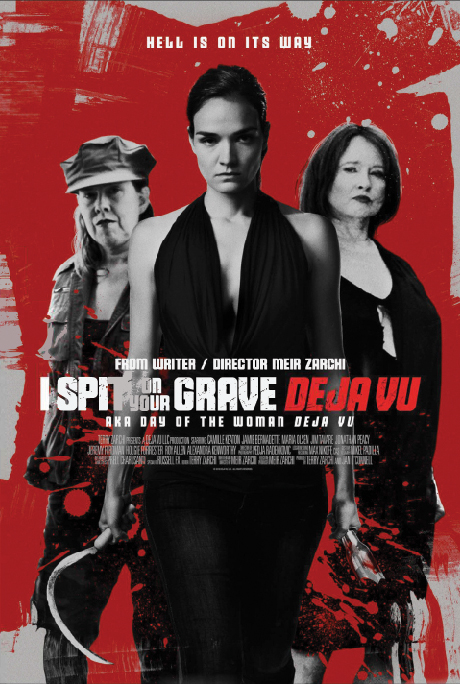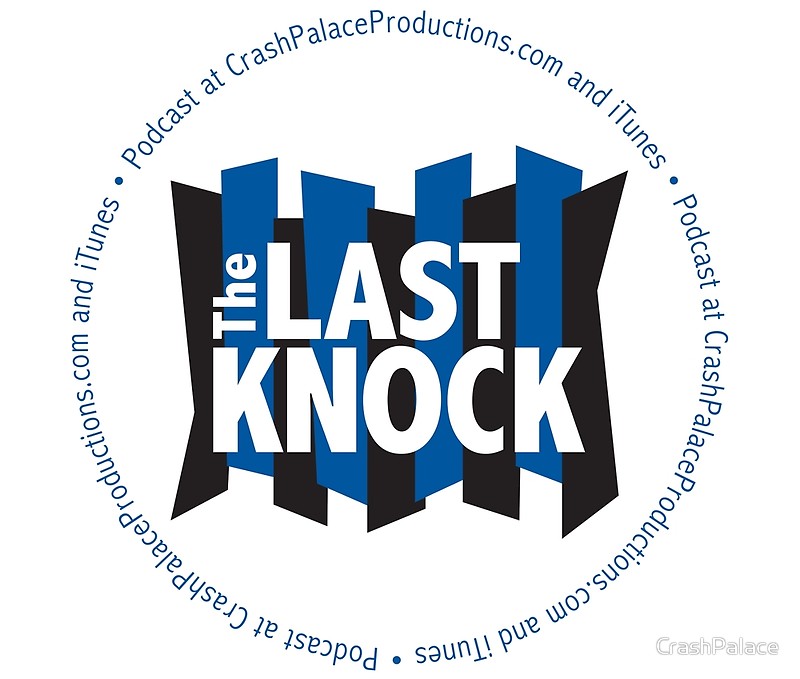
Déjà Vu: The Vengeance Cinematic Universe
Long before I Spit on Your Grave Deja Vu, chronicling the brutal rape of Jennifer Hills (a fearless Camille Keaton) over the course of a fateful day, 1978’s I Spit on Your Grave didn’t flinch from depictions of full nudity and violent retribution. The men of the piece barreled forward into their brutal crime with an amoral groupthink that crumbled into cowardice upon discovering their victim lived on, after the act had been consummated in dirt and blood.
Where Meir Zarchi’s film diverged from a backwoods antecedent like Deliverance was in its utter lack of philosophical dialog on man’s inherent savagery, and the dismissal of the rule of law when one is so far-removed from “civilization.” Despite what its detractors claim, there is much subtext in Grave, and much work for the viewer to apply toward comprehending the characters’ backstories and motives. Unlike the rough-and-tumble Last House on the Left, Grave contains careful compositions that align it more closely with contemplative art-house fare.
When Zarchi recorded a commentary for Elite’s “Millennium Edition” DVD in 2004, it was a treasure trove of revelations that nonetheless preserved the film’s oblique mystique. Despite my own contradictory feelings toward Grave, understanding the inspiration that led to its creation firmly established Zarchi as a serious artist, not an opportunistic schlockmeister.
Maybe it wasn’t surprising that Grave was remade in 2010, with Zarchi as executive producer. Like any successful remake, the film kept true to the original while pushing the plot and characters in a different direction. Stuart Morse’s script was as incisive in exploring battle-of-sexes subtext as it was in finding new ways to deliver bloody catharsis. Even the heinously vulgar dialog conveyed a sense of meticulous craftsmanship.
Still, it felt strange that I Spit on Your Grave, of all films, had spawned a franchise over three decades after the original’s theatrical bow. But if stuff like Inside and Martyrs can get the remake treatment, what’s keeping Blumhouse from giving us an updated Salo?
A Proper Sequel?
Per the Elite DVD commentary, Zarchi was enthusiastic about making a “proper” sequel to the 1978 film. These days, interviews with iconic horror filmmakers inevitably dance around long-mooted sequels they “really want to” make someday.
Rare is the seasoned auteur who has enough passion – and financial backing – to bring a long-mooted concept to the screen. Remakes by young up-and-comers have taken the place of sequels by genre veterans. But continuing the tales of iconic horror characters by their original creators can be a double-edged machete: both versions of The Hills Have Eyes 2 bore Wes Craven’s name in some creative capacity, and both were products of cash-grab cynicism. There’s the rub: while many horror fans pine for veteran directors to be given another chance, what are the odds that that chance will be squandered?
To be honest, I thought Zarchi was blowing smoke – more infatuated by the notion of a sequel than actually making one.
But a few years ago, blurbs on horror sites bubbled up, along with teaser images from I Spit on Your Grave Deja Vu. In 2015, Maria Olsen (Starry Eyes) and Jamie Bernadette (4/20 Massacre) were interviewed by Billy Crash on The Last Knock podcast. Suddenly, the sequel seemed ever closer to reality.
As a fan of the 1978 film, the news that Deja Vu would finally see light of day became a much-anticipated event. Could Zarchi, after nearly 40 years, justify the return of – and maintain continuity with – his original creation? What could be left to explore on the subject of eye-for-an-eye vengeance that hadn’t been done countless times since?
A Merging of Worlds
At 148 minutes, I Spit on Your Grave Deja Vu is Zarchi unleashing an intimate story in sprawling, epic fashion. The scope alone echoes recent efforts from Tarantino (The Hateful Eight) and S. Craig Zahler (Dragged Across Concrete). Not unlike these filmmakers, Zarchi utilizes a deliberate pace with great success. While certain scenes could’ve been trimmed, even the meandering asides help shade in the characters, and rarely feel excessive.
One jarring aspect of the 1978 film was how the rapists weren’t inbred hicks, but lower-middle-class types whose sexual repression anticipated a violent, primal awakening. For example, gas-station proprietor Johnny (Eron Tabor) was a far cry from the Appalachian who fills up the station wagon in Deliverance. An inability to pigeonhole the rapists probably frustrated critics looking to dismiss the film. (This was adjusted accordingly for the 2010 remake, which took a more straightforward approach to its male monsters.)
Deja Vu‘s villains are the relatives of the men Jennifer murdered in the 1978 film. Keaton reprises her role, having found success in a memoir about her experience. Her adult daughter, Christy (Bernadette) is a world-renowned fashion model. After meeting for lunch at an out-of-the-way restaurant, they are accosted by the trio of Becky (Maria Olsen), Kevin (Jonathan Peacy), and Scotty (Jeremy Ferdman). With minds fixated on revenge, they make Zarchi’s scriptural “eye for an eye” intent explicit.
Placing Deja Vu within the framework of the Grave Extended Universe, one must make a leap in what they know of the original characters. While Jennifer and her assailants were semi-vague riddles in the 1978 film, this sequel derives bits of personality from the rapists in the 2010 film, falling more in line with “backwoods shitkicker” stereotypes.
That’s not to say the characters are generic. Becky, distraught and mad with grief over the death of Johnny, is also prone to moments of base-level spirituality as a justification for her deeds (Olsen’s performance is a marvel of driven commitment – the type of lead role she’s long deserved); Kevin (brother of Anthony Nichols’ Stanley) is a violent hothead with not much upstairs; and Scotty (cousin of Gunter Kleemann’s Andy) is like a corollary to Justin in the Last House on the Left remake – he’s the youngest of the bunch, and naïve to just how bad the consequences can be. Also looming about is Herman (Jim Tavaré), father of the mentally challenged Matthew (Richard Pace). Zarchi’s commitment to this vision of the characters strengthens the narrative.
Improbability = Strength
One of the idiosyncrasies of Grave is how it removes itself from notions of conventional reality. A day of sunbathing becomes a freefall into a nightmare – we hope Jennifer will wake up in the safety of her home, but that’s where Zarchi brings reality crashing down with unforgiving brutality. As a complement to this approach, law enforcement – often obligatory in rape-revenge films (again, see Last House) – is nowhere to be found.
Not unlike Tarantino and Zahler’s pulp landscapes, I Spit on Your Grave Deja Vu exists within a realm of improbability that lends it a dreamlike sheen. From the unlikely abduction of Jennifer and Christy (even with the restaurant nearby, nobody seems to hear anything); the ritualistic murder of a character on a church stoop; the way Becky always seems to appear out of nowhere on her ATV; and the elderly couple (Holgie Forrester and Roy Allen III) who show up at opportune times to deliver Jennifer and Christy from danger, little seems to be taking place in the Real World.
Surprisingly, Zarchi downplays the rape element here. While the revenge is violent and creative, it’s more effective in its drawn-out pacing than the bloody “money shots.” Christy, like Jennifer, lures her attackers by lowering their guard and bringing out an unexpected humanity, leading to a one-two punch of savage catharsis. Her vengeance becomes otherworldly, awakening a dormant – yet omnipresent – survival instinct. This lends Christy’s retribution a certain cavalier Kill Bill feel, and Bernadette’s performance conveys a true sense of body and mind driven to their absolute breaking points.
Nightmare Logic
In the 1978 film and I Spit on Your Grave Deja Vu, the rapists’ sadism manifests in the confidence that the universe they inhabit will always bend in their favor. Therefore, what’s the harm in giving those without a chance a head start? There is an elliptical quality and poetic justice to Zarchi’s scenarios – “what goes around comes around,” indeed.
Adding to Déjà Vu’s surreal atmosphere is the rapists’ graves, marked with wooden crosses painted black. Does this indicate that they don’t belong in the company of God’s followers? That their souls have been burnt to a cinder in hell? And whom, exactly, is tending these markers after 40 years? This is just one detail that adds to the film’s dreamlike quality.
Zarchi creates an inescapable world – an existential conundrum in which someone can pound on the doors of a church, only to be ignored. As if to say, “don’t drag God into your mortal dealings – find a way to resolve them yourself.” Maybe that speaks to the relentless, Passion of the Christy torment Bernadette endures in the name of her own vengeance. There is a beautiful visual near the end that suggests trauma is a burden we carry, like an inexorable psychological weight. But by that same token, holding on to something to be a martyr is no reason to hold on at all. Throughout, it’s the female characters who show the greatest resolve and refuse to quit, even when circumstances appear hopeless.
More is More
While low budget, I Spit on Your Grave Deja Vu is not the soulless, self-indulgent vanity piece it could’ve been. And the run time allows the characterizations to breathe and the suspense to percolate. That said, this approach will not appeal to viewers looking for a ramped-up carnage-fest, even though there is a definite sense of craftsmanship to the violence.
One might question why Jennifer wrote a memoir of her experience 40 years after the fact, but consider how, just last year, Laurie Strode was presented as a hard-bitten survivalist lying in wait for Michael Myers for the same stretch of time. The contrast between these Final Women is interesting: Jennifer has found a way to make peace with the horrors of her past; Laurie, however, is reduced to a more basic, Sarah Connor-styled badass. Between Halloween’18 and Deja Vu, it’s the latter that carries the most impact.
In addition to Tarantino and Zahler, Zarchi also evokes the backwoods atmosphere of a Rob Zombie flick. When the family members enact their vengeful agenda, it’s profane and sadistic…but there’s a sneaky depth to the vulgarity. Despite their deeds, the Firefly Family were still a family, and Zombie found ways to imbue them with humanity. His films, like Grave, endure for the questions they raise and the gray areas they explore. The same applies to I Spit on Your Grave Deja Vu. When sequences of violence and humiliation give way to artfully-shot moments where, say, a widow delivers a heartfelt elegy at her husband’s grave, it conveys genuine passion on Zarchi’s part. It’s fascinating because it’s murky.
3.5 out of 5 stars
The Plot Sickens: Crash interviews Jamie Bernadette and Maria Olsen!
Crash Analysis Support Team
Jonny Numb

Jonny Numb (aka Jonathan Weidler) never learned how to swim, but can float just fine. He co-hosts The Last Knock podcast with Billy Crash, and can be found in the social-media sewers of Twitter and Letterboxd @JonnyNumb.
Get your Crash Palace and The Last Knock gear! 
THE LAST KNOCK horror podcast is a Crash Palace Productions’ featured show. Besides this site, you can find THE LAST KNOCK on iTunes with new shows posted every other Sunday at 9 PM ET.
Crash Palace Productions website design and creation from Brian Yount Digital Enterprises with banner and THE LAST KNOCK art from Palko Designs. Logo designs from Paul Belci.
(I Spit on Your Grave Deja Vu movie poster from Deja Vu.)
